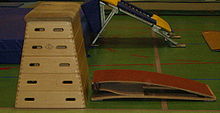
Gymnastics is a type of sport that includes physical exercises requiring balance, strength, flexibility, agility, coordination, artistry and endurance. The movements involved in gymnastics contribute to the development of the arms, legs, shoulders, back, chest, and abdominal muscle groups. Gymnastics evolved from exercises used by the ancient Greeks that included skills for mounting and dismounting a horse, and from circus performance skills.

The vault is an artistic gymnastics apparatus which gymnasts perform on, as well as the skill performed using that apparatus. Vaulting is also the action of performing a vault. Both male and female gymnasts perform the vault. The English abbreviation for the event in gymnastics scoring is VT.

The balance beam is a rectangular artistic gymnastics apparatus and an event performed using the apparatus. Both the apparatus and the event are sometimes simply referred to as "beam". The English abbreviation for the event in gymnastics scoring is BB. The beam is a small, thin beam which is typically raised from the floor on a leg or stand at both ends. The balance beam is only performed competitively by female gymnasts. Beams are usually covered with leather-like material and are only four inches wide.

The uneven bars or asymmetric bars is an artistic gymnastics apparatus. It is made of a steel frame. The bars are made of fiberglass with wood coating, or less commonly wood. The English abbreviation for the event in gymnastics scoring is UB or AB, and the apparatus and event are often referred to simply as "bars". The bars are placed at different heights and widths, allowing the gymnast to transition from bar to bar. A gymnast usually adds white chalk to the hands so that they can grip the bar better.
Artistic gymnastics is a discipline of gymnastics in which athletes perform short routines on different apparatuses. The sport is governed by the Fédération Internationale de Gymnastique (FIG), which assigns the Code of Points used to score performances and regulates all aspects of elite international competition. Within individual countries, gymnastics is regulated by national federations such as British Gymnastics and USA Gymnastics. Artistic gymnastics is a popular spectator sport at many competitions, including the Summer Olympic Games.

Marian Drăgulescu is a former Romanian artistic gymnast. During his senior gymnastics career he won 31 medals at Olympic Games at World and European Championships, of which eight are gold medals at the World Championships and ten are gold medals at European Championships. Drăgulescu's strongest events were vault and floor, on which he was a multiple world champion and Olympic medalist. The handspring double front somersault with ½ turn is named after him in the Code of Points. In the all-around, Drăgulescu was the European champion (2004) and bronze medalist (2000) and placed 8th at the 2004 Olympic Games.

At the 1980 Summer Olympics, fourteen different artistic gymnastics events were contested, eight for men and six for women. All events were held at the Sports Palace of the Central Lenin Stadium in Moscow from July 20 through 25th. Several teams who had qualified to compete were absent as a result of the 1980 Summer Olympics boycott, including the United States, Canada, China, Japan, South Korea, and West Germany.

The Code of Points is a rulebook that defines the scoring system for each level of competition in gymnastics. There is not a universal international Code of Points, and every oversight organization — such as the FIG, NCAA Gymnastics, and most national gymnastics federations — designs and employs its own unique Code of Points.
Mats are used for safety in gymnastics, and in training new skills. They are usually a piece of foam ranging from 1.5 to 28 inches thick, covered in a vinyl or plastic lining. The foam ranges in density from relatively firm to very soft.
Cheng Fei is a Chinese retired artistic gymnast. She is a three-time World Champion on the vault (2005–2007) and 2006 World Champion on floor exercise. She was a member of the gold medal-winning Chinese teams for the 2006 World Artistic Gymnastics Championships in Aarhus, Denmark and 2008 Olympic Games in Beijing, China. She was also a member of the silver medal-winning Chinese team for the 2007 World Artistic Gymnastics Championships in Stuttgart, Germany.

Yurchenko, also known as round-off entry vaults, are a family of vaults performed in artistic gymnastics in which the gymnast does a round-off onto the springboard and a back handspring onto the horse or vaulting table. The gymnast then performs a salto, which may range in difficulty from a simple single tuck to a triple twist layout. Different variations in the difficulty of the salto lead to higher D-scores. This family of vaults is the most common type of vault in gymnastics and it's named after Natalia Yurchenko, who first performed it in 1982.

The men's vault competition was one of eight events for male competitors of the artistic gymnastics discipline contested in the gymnastics at the 2004 Summer Olympics in Athens. The qualification and final rounds took place on August 14 and August 23 at the Olympic Indoor Hall. There were 79 competitors from 30 nations, with nations competing in the team event having up to 5 gymnasts and other nations having up to 2 gymnasts. The event was won by Gervasio Deferr of Spain, the third man to successfully defend an Olympic title in the vault and sixth man to win multiple medals of any color. Latvia and Romania each earned their first men's vault medals, with Evgeni Sapronenko's silver and Marian Drăgulescu's bronze, respectively.
This is a general glossary of the terms used in the sport of gymnastics.

The men's vault competition at the 2008 Summer Olympics was held on August 9 and 18 at the Beijing National Indoor Stadium. The eight competitors with the highest scores in qualifying, among the gymnasts electing to make two vaults, proceeded to the men's vault finals. There, each gymnast performed two vaults; the scores from the final round determined final ranking. There were 16 competitors from 13 nations that made a second vault attempt. The event was won by Leszek Blanik of Poland, the nation's first victory in the men's vault. Blanik was the seventh man to win multiple medals in the event, adding to his 2000 bronze. France earned its first medal in the event with Thomas Bouhail's silver. Anton Golotsutskov of Russia took bronze, putting the nation back on the podium after a one-Games absence.
The men's vault event was part of the gymnastics programme at the 1924 Summer Olympics. It was one of nine gymnastics events and it was contested for the third time after 1896 and 1904. The competition was held on Monday, July 21, 1924. Seventy gymnasts from nine nations competed. The eight members of each nation's gymnastics team all competed; Czechoslovakia only had six competitors start the vault. The event was won by Frank Kriz of the United States, the nation's second consecutive victory in the event. Jan Koutný and Bohumil Mořkovský of Czechoslovakia took silver and bronze, respectively, the nation's first medals in the event.
The Artistic Gymnastics World Cup is a competition series for artistic gymnastics sanctioned by the Fédération Internationale de Gymnastique (FIG). It is one of the few tournaments in artistic gymnastics officially organized by FIG, as well as the World Championships and the gymnastics competitions at the Olympic Games and the Youth Olympics. Beginning in the 2017-2020 quadrennium, the All-Around and Individual Apparatus World Cup series are used to qualify a maximum of seven spots to the Olympic Games.

The men's vault competition was one of eight events for male competitors in artistic gymnastics at the 2000 Summer Olympics in Sydney. The qualification and final rounds took place on September 16 and 25 at the Sydney SuperDome. There were 80 competitors from 31 nations; nations competing in the team event could have up to 5 gymnasts in the vault, while other nations could have up to 2 gymnasts. The event was won by Gervasio Deferr of Spain, the nation's first medal in the men's vault. Poland also earned its first medal in the event, with Leszek Blanik's bronze. Silver went to Alexei Bondarenko of Russia.

The men's vault competition at the 2016 Summer Olympics in Rio de Janeiro was held at the HSBC Arena on 15 August 2016. There were 17 competitors from 14 nations. The event was won by Ri Se-gwang of North Korea, the nation's first medal in the men's vault. Denis Ablyazin repeated as silver medalist, the eighth man to win multiple medals in the event. Kenzō Shirai earned Japan's first medal in the men's vault since 1984 with his bronze.

The men's vault event at the 2020 Summer Olympics was held on 24 July and 2 August 2021 at the Ariake Gymnastics Centre. Unlike the other apparatus events, vault requires gymnasts to perform two exercises in order for results to count towards the vault final; most of the gymnasts perform only one or none. Approximately 20 gymnasts from 15 nations competed two vaults in the qualifying round.

The women's vault event at the 2020 Summer Olympics was held on 25 July and 1 August 2021 at the Ariake Gymnastics Centre. Unlike the other apparatus events, vault requires gymnasts to perform two exercises in order for results to count towards the vault final; most of the gymnasts perform only one or none. Approximately 20 gymnasts from 15 nations competed two vaults in the qualifying round.














